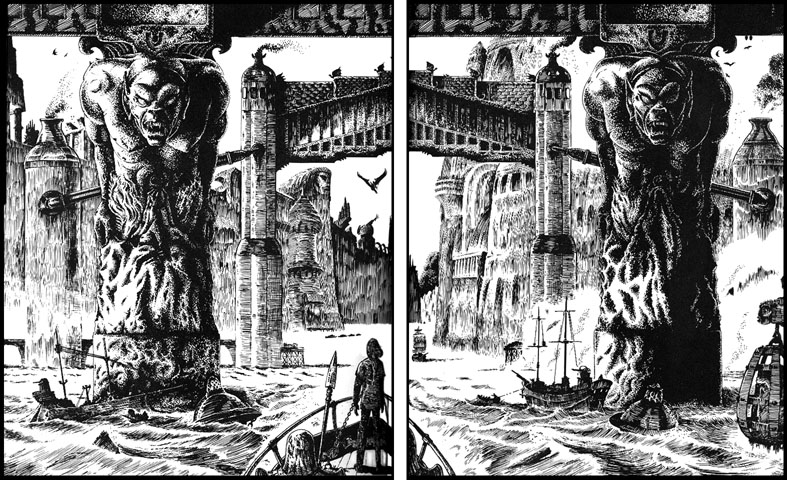The History of the Runestaff by Micheal Moorcock contains four novels The Jewel In The Skull, The Mad God's Amulet, The Sword Of The Dawn, and The Runestaff.
I found reading though the books a bit of a slog, not that Moorcocks writing is challenging or the ideas were particularly less interesting than his other works, but the protagonist Dorian Hawkmoon of Koln is somewhat dull. Unlike the tortured, disfigured and somewhat reluctant incarnations of the Eternal Champion - Elric of Melniboné and Corum Jhaelen Irse, Hawkmoon is hero cast in the more traditional mould of Swords & Sorcery hero - a natural leader, a military man, determined, proud and valiant. While he is as much a pawn of higher powers beyond his comprehension as the others, he takes his fate with aplomb - he's also more human, rather than the elvish Vadhagh or Melnibonéan.
 |
| Jim Cawthorn : Map of the Dark Empire |
Then there's Hawkmoons world, which for all intents and puropses is a post-post-apocalyptic Earth, with clear references to real world place names, and people - notably figures from the pre-catastrophy 1960s such as The Beatles and Harold Wilson. These references are just an incidental gloss rather than being used for amusing the or satirical effect. I found it slightly grating and lacking the spark of sardonic wit and psychedelic verve that accompanies Moorcocks other stories, but then I've never liked The Beatles. Maybe living in a post-truth, post-brexit, economically and culturally insecure Britain of the 21st century, the idea of the island of Granbretan (Great Britain) invading and unifying mainland Europe by force with legions of animal masked warriors fails to resonate all that much. Yet.
 |
| Jim Cawthorn : The Emperor |
There certainly are high-points of effective prose - pirate cultists carrying out a grisley ritual, and Hawkmoons summoning a legion of undead legion of southern barbarians using his Sword of the Dawn is evoked with a deftness and weirdness that is striking. Other encounters with the weird, such as the ghostly elfin inhabitants of ancient cities aren't quite as successful, and seem a little out of place in an otherwise earth-bound fantasy sequence. The walls of the multiverse grow thin and stranger things step across the dimensions.
 |
| Jim Cawthorn : The Palace of Taragon |
The big-bad-end-guy is the immortal King-Emperor Huon, an immortal being, entrapped in his Globe Throne, served by bickering political factions. Huon is eventually usurped by his second in command, a revolution that Hawkmoon uses to finally defeat his enemy despite serious losses of friends.
 |
| Jim Cawothorn : Jewel in the Skull |
Under the Nefarious Influence of the Dark Empire
The second edition of Warhammer Fantasy Battle was dedicated to Moorcock, Tolkien and Phil Barker. The influence of Moorcock in early Warhammer is everywhere, from incidental art clearly depicting Elric to the eternal struggle of Chaos and Law and back again.There are specific motifs that stem from the Hawkmoonian milleu - the use of real-world geographical cues being a fundamental one, as are the punning references to contemporary pop-culture and political figures, which abound in early Warhammer. The entire 'expected to be good guys are actually bad guys' trope of the Empire in 40k reflected in Gran Bretan except Moorcock has the decency to have actual good guys who fight oppression, so the whole universe doesn't descend into the hate-thy-neighbour fascist philosophy like 40k does.
The story of the King-Emperor being usurped by his most powerful and at one point trusted warlord is one that resonates down to ancient times, but it's also clear precursor of The Horus Heresy. The thematic legions such as Meliadus' Order of the Wolf are echoed in the Space Wolf Chapter of the Space Marines. The insane gothic splendour of Londra reflected in a billion Imperial buildings.
 |
| Jim Cawthorn : The Bridges of Londra |
The Lost Chronicles of Mournblade
At one point GW speculated on developing a Warhammer supplement based on the Elric Saga, so why not other incarnations of the Eternal Champion? Most of the characters and troops would be standard human / hero / major hero profiles, with only their arms, armour and techno-sorcerous equipment to really differentiate them. So here follows some musing and rules on the weaponry in Hawkmoons world at the time of the Dark Empire:
The Flame Lance
The Flame Lance
The First Citadel Compendium (1983) gives stats for The Flame Lance - an energy weapon that appears in History of the Runestaff, wielded by the goodly legions of Kamarg under the command of the mighty Count Brass.
 |
| Flame Lance - Citadel Compendium |
The firing, discharge and re-energising cycle is pretty spot on for the Flame Lance of Hawkmoon. It isn't quite a laser weapon - having features of both laser and fire weapon, but it's a reasonable write up that hews closely to the text. People often talk about Moorcocks influence on Warhammer in a vague or loose sense -chaos, critical self-awareness of genre - but this is a straight-forward adaptation, showing I think the impact and importance of Moorcocks works and Warhammer being specifically designed to translate those stories into games.
 |
| Eternal Champion: Citadel Journal (1986) Hawkmoon Bottom Right Designed by Jes Goodwin, painted by John Blanche |
Jes even included what looks like a Flamelance on his figure of Hawkmoon for Citadels BC5 Eternal Champion Boxed Set (photo, bottom right). Hawkmoon doesn't wield one in The History of the Runestaff series, does in the contnuation Count Brass. Either way it's an iconic weapon from the stories that certainly deserves representation. The Citadel Journal article gives the flamelance the following stats:
Flamelance: SR: 12" LR: 30" 1D6 S6 hits. 3 turns to reload.
The elongated flame weapon concept would continue into 40ks Eldar energy weapon / polearm hybrid weapons - notably the Fire Pike of the Fire Dragon Exarch, Flame-Lance, Fire-Pike.
 |
| Eldar Fire Dragon Exarch with FirePike | via |
It's slightly more powerful than both the 1st Edition Warhammer and 2nd Edition versions above, and if the 3 shots a day limit were re-instated, this would make a good statline for the Flame Lance.
So what of the other artefacts from Hawkmoons plane of the multiverse?
The Runestaff
A multidimensional artefact of immense power, the Runestaff appears as an ornate wooden pole, some 6ft tall, encrusted with shifting and ancient runes. Weird lights and patterns project out from the staff, making a dazzling psychedelic display in the air around the user. The Runestaff is a Battle Standard which weaves the strands of fate around its wielder, allowing the unit that carries it to re-roll any dice in combat, and cause Fear in chaotic units within 12" . 150PV
The Sword of the Dawn
For a skirmish-level and low points value games The Sword of the Dawn summons 1d6 Warriors of the Dawn. For a full-scale wargame, the forces summoned by the Sword should really be calculated in at the outset, but placed on the tabletop within 24" of the wielder. 200PV
Warriors of the Dawn
The warriors summoned by the Sword of the Dawn carry Spears and Shields, and have a standard human profile. However, when defeated in combat, a new Warrior of the Dawn appears next turn, within 12" of the bearer of the Sword of the Dawn, to a maximum of 3 regenerations.
The Amulet of the Gods
Lends strength and wellbeing to its wearer. +1 Strength +1 Toughness. 50PV
The Jewel in the Skull
The Jewel in the Skull is a piece of arcane technology developed by the Dark Empire of Granbretan to control Hawkmoon. Each turn, an opposing player may attempt to activate the Jewel. Roll 1d6
1-2. The jewel remains inactive. No effect.
3. The victim is wracked with pain. Lose 1 W
4. Black-out. The victim may do nothing for 1d6 turns.
5. Complete mind control. The opposing player may decide actions of the character.
6. Full activation. The victim is dead.
Possession of the Runestaff will nullify the effects of the Jewel in the Skull.
Mirrorhelm
Again, the Eldar are described with something very similar - in this case the Harlequins Rictus Mask (White Dwarf 106 / 40K Compilation). The mirrorhelms are worn in the final march against Granbretan by Hawkmoon and the other heroes. A strangely-wrought reflective helmet that replaces the attackers face with that of the victim. Causes Fear in hand-to-hand combat. 25PV
Funny, that whilst I'd consider these the weakest of Moorcocks stories I've read, the idea of gaming some of the conflicts using the characters and armaments seems really quite appealing.
- History of the Runestaff at Amazon
- Citadels Eternal Champion Miniatures Range at Stuff of Legends
- Eureka Miniatures Hawkmoon Miniatures Range at Eureka Miniatures
- Review of Chaosiums 1986 Hawkmoon RPG at Grognardia













